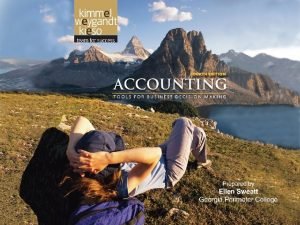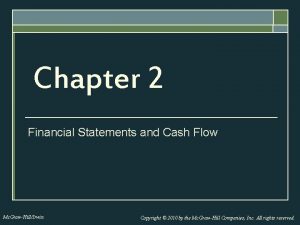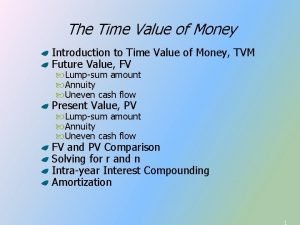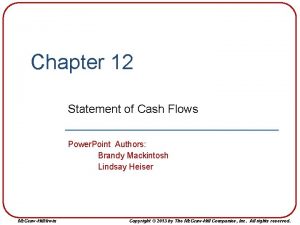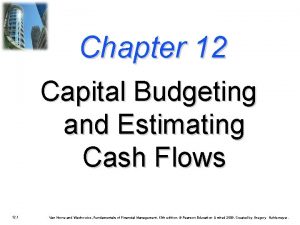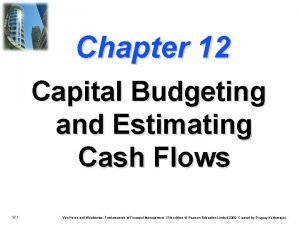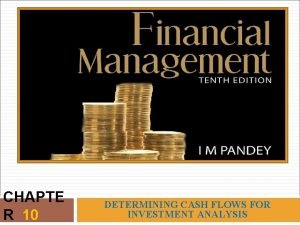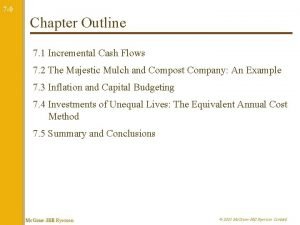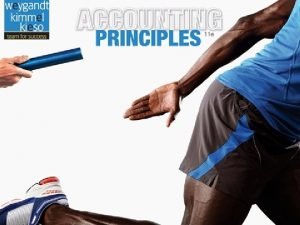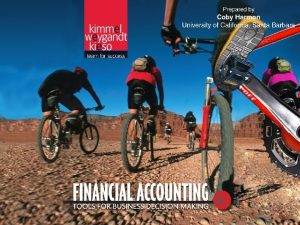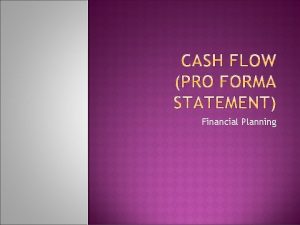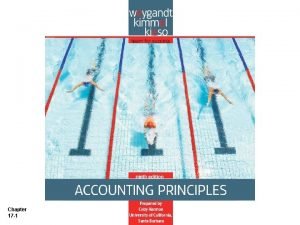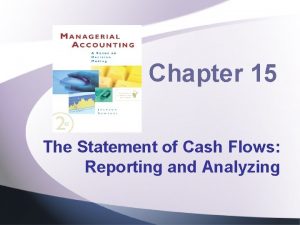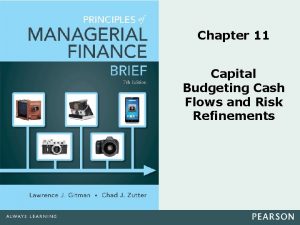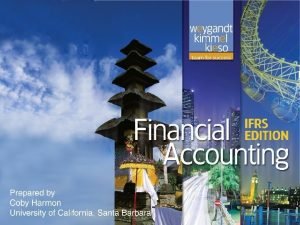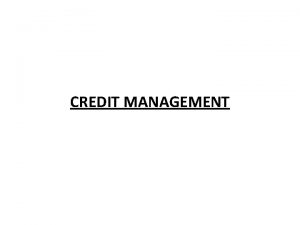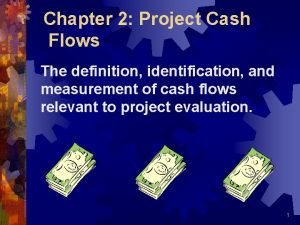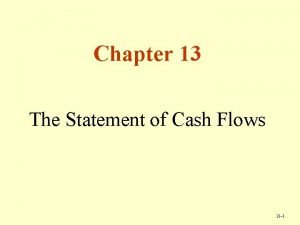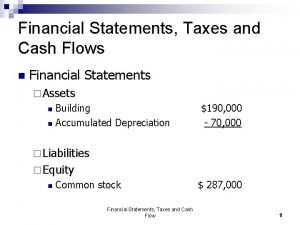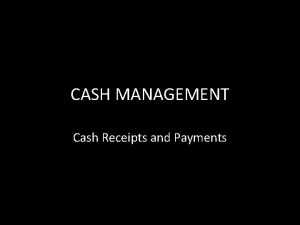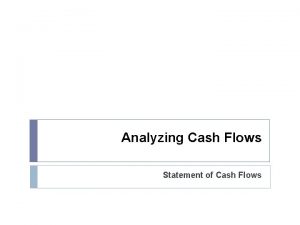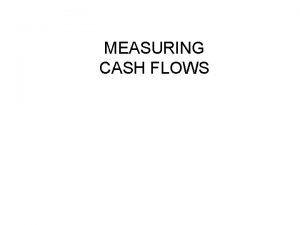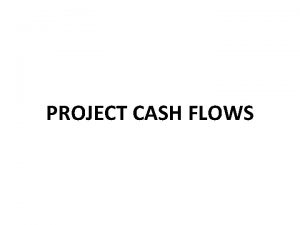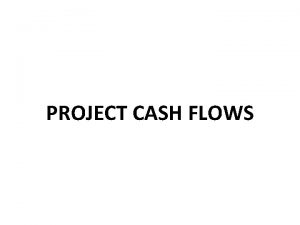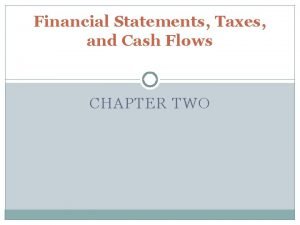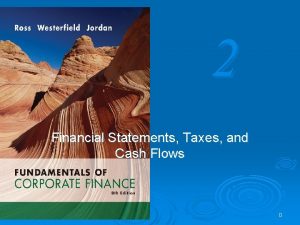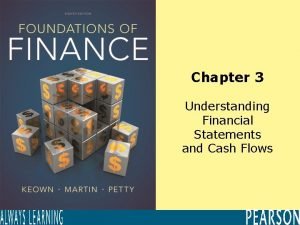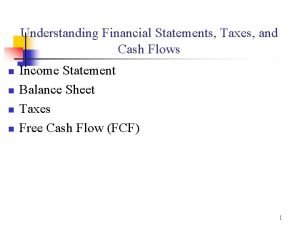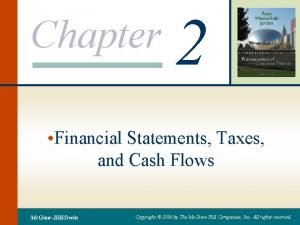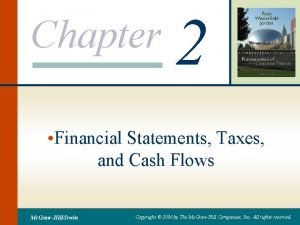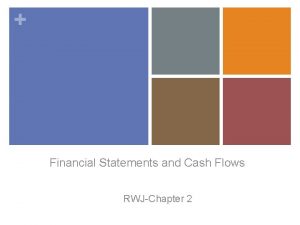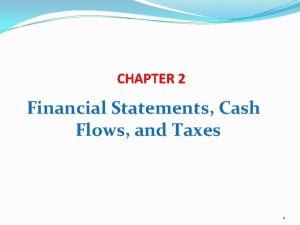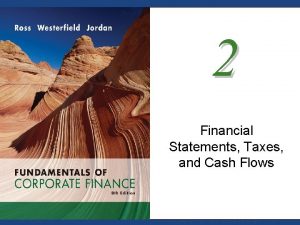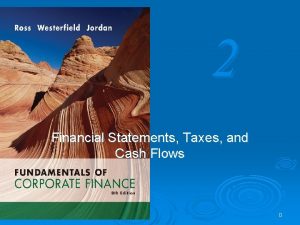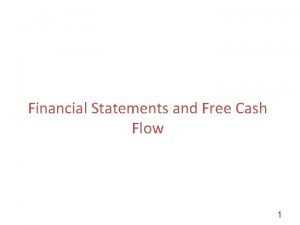Financial Statements and Cash Flows Source of Information





















- Slides: 21

Financial Statements and Cash Flows

Source of Information § Annual Reports § Wall Street Journal § Internet: § § § NYSE (www. nyse. com) NASDAQ (www. nasdaq. com) Yahoo/Google Finance Morningstar (www. morningstar. com) SEC-EDGAR Financial Statements and Cash Flows 2

Financial Statements § (1) Balance Sheet § (2) Income Statement Financial Statements and Cash Flows 3

Financial Statements-Balance Sheet (B/S) § (1) Balance Sheet § It reports a company’s assets, liabilities, and shareholder equity at a specific point in time § Assets = Liabilities + Shareholder’s Equity § Nike, Inc. (NKE) § https: //finance. yahoo. com/quote/NKE/balance-sheet? p=NKE Financial Statements and Cash Flows 4

Nike, Inc. Balance Sheet Financial Statements and Cash Flows 5

Important Rules in B/S § The assets are listed in order by the length of time it would normally take a firm with ongoing operations to convert them into cash. § Clearly, cash is more liquid than property, plant, and equipment. § Liquidity: § § § It refers to the ease and quickness with which assets can be converted to cash – without a significant loss in value. Current assets are the most liquid. The more liquid a firm’s assets, the less likely the firm is to experience problems meeting short-term obligations. Liquid assets frequently have lower rates of return than fixed assets Some fixed assets are intangible. § Debt versus Equity: § Creditors generally receive the first claim on the firm’s cash flow. § Shareholder’s equity is the residual difference between assets and liabilities. § Value versus Cost § Under Generally Accepted Accounting Principles (GAAP), audited financial statements of firms in U. S. carry assets at cost, i. e. , historical cost. The numbers in B/S are called “Book Value. ” § “Market Value” is the price at which the assets, liabilities, ad equity could actually be bought or sold. § Market Value and Book Value are completely different. Financial Statements and Cash Flows 6

Financial Statements-Income Statement(I/S) § (2) Income Statement § It measures financial performance over a specific period of time. § Three important parts: § (i) Operations § (ii) Non-operating (financing) § (iii) Taxes § Nike, Inc. (NKE) § https: //finance. yahoo. com/quote/NKE/financials? p=NKE Financial Statements and Cash Flows 7

Nike, Income Statement Financial Statements and Cash Flows 8

Nike, Income Statement-Operations The operations section of I/S reports the firm’s revenues and expenses from principal operations Financial Statements and Cash Flows 9

Nike, Income Statement-Non-Operating (Financial) The non-operating section of the I/S includes all financing costs (revenues), such as interest expense Financial Statements and Cash Flows 10

Nike, Income Statement-Taxes Usually a separate section reports the amount of taxes levied on income Financial Statements and Cash Flows 11

Nike, Income Statement-Net Income (Earnings) is the “Bottom Line” item Financial Statements and Cash Flows 12

Discussion: How important is the I/S? § Earnings: § “excessive emphasis being laid on the reported earnings -- which might only be temporary or even deceptive. ” Benjamin Graham Financial Statements and Cash Flows 13

Discussion: How important is the I/S? § Gross Profitability § https: //www. wsj. com/articles/SB 10001424127887323293704578334491900368844 § https: //www. sciencedirect. com/science/article/pii/S 0304405 X 13000044 § Trend in Gross Profitability § https: //www. aaajournals. org/doi/abs/10. 2308/accr-51708 § Operating Profitability § https: //www. sciencedirect. com/science/article/pii/S 0304405 X 15000203 Financial Statements and Cash Flows 14

Important Rules in I/S § GAAP: § The matching principle of GAAP dictates that revenues be matched with expenses. § Thus, income is reported when it is earned, even though no cash flow may have occurred. § Non-Cash Items § Depreciation is the most apparent. No firm ever writes a check for “depreciation. ” § Another non-cash item is deferred taxes, which does not represent a cash flow. § Thus, net income is not cash. Financial Statements and Cash Flows 15

One more concept: Working Capital Financial Statements and Cash Flows 16

Nike, Inc. -Working Capital WC(2019)= CA(2019) - CL(2019) = 16, 525 - 7, 866 = 8, 659 WC(2018)= CA(2018) - CL(2018) = 15, 134 - 6, 040 = 9, 094 ΔWC(2019)= WC(2019) - WC(2018) = 8, 659 - 9, 094 = -435 This decrease of $435 million is available to shareholders Financial Statements and Cash Flows 17

Cash Flows Financial Statements and Cash Flows 18

Cash Flows Financial Statements and Cash Flows 19

OCF, OFCF, and FCF of Nike, Inc. § OCF § § EBIT = 4, 772 Depreciation = 720 Taxes = 772 OCF=4, 772+720 -772=4, 720 § OFCF § § OCF=4, 720 CAPEX=LT Asset (2019) – LT Assets (2018) + Depreciation = 7, 192 – 7, 402 + 720 = 510 ΔWC=WC(2019) – WC(2018) = -435 OFCF = 4, 720 – 510 – (-435) = 4, 645 § FCF § § § NI = 4, 029 Depreciation = 720 CAPEX = 510 ΔWC = -435 ΔLT Debt = LT Debt (2019) – LT Debt (2018) = 6, 811 – 6, 684 = 127 FCF = 4, 029 + 720 – 510 – (-435) + 127 = 4, 801 Financial Statements and Cash Flows 20

Thanks! Is Change of Style Evidence of Skill? 21
 Which budget shows anticipated cash flows
Which budget shows anticipated cash flows Cash flow to creditors is equal to
Cash flow to creditors is equal to Chapter 2 financial statements taxes and cash flow
Chapter 2 financial statements taxes and cash flow Pv of cash flows formula
Pv of cash flows formula Incremental cash flows
Incremental cash flows Discounted payback period formula
Discounted payback period formula Cash flow indirect method
Cash flow indirect method Incremental cash flow
Incremental cash flow Incremental cash flows
Incremental cash flows Working capital investment example
Working capital investment example Iatcf
Iatcf Statement of cash flows order
Statement of cash flows order What are plant assets
What are plant assets Project implementation cost
Project implementation cost Prepaid expenses in cash flow statement
Prepaid expenses in cash flow statement The statement of cash flows reports
The statement of cash flows reports Capital budgeting
Capital budgeting Cash is current asset or not
Cash is current asset or not 2/10 net 30
2/10 net 30 Chapter 23 statement of cash flows
Chapter 23 statement of cash flows Relevant cash flows definition
Relevant cash flows definition The statement of cash flows classifies items as
The statement of cash flows classifies items as
